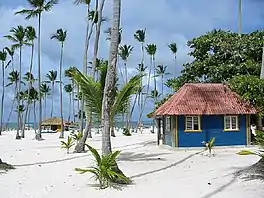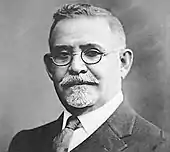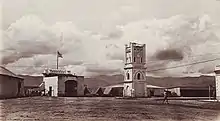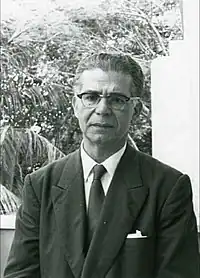Portal:Dominican Republic
Introduction
The Dominican Republic (/dəˈmɪnɪkən/ də-MIN-ik-ən; Spanish: República Dominicana, pronounced [reˈpuβlika ðominiˈkana] ⓘ) is a country located on the island of Hispaniola in the Greater Antilles archipelago of the Caribbean region. It occupies the eastern five-eighths of the island, which it shares with Haiti, making Hispaniola one of only two Caribbean islands, along with Saint Martin, that is shared by two sovereign states. The Dominican Republic also borders the Atlantic Ocean to the north. It is the second-largest nation in the Antilles by area (after Cuba) at 48,671 square kilometers (18,792 sq mi), and third-largest by population, with approximately 10.7 million people (2022 est.), down from 10.8 million in 2020, of whom approximately 3.3 million live in the metropolitan area of Santo Domingo, the capital city. The official language of the country is Spanish. After more than three hundred years of Spanish rule, the Dominican people declared independence in November 1821. The leader of the independence movement, José Núñez de Cáceres, intended the Dominican nation to unite with the country of Gran Colombia, but the newly independent Dominicans were forcefully annexed by Haiti in February 1822. Independence came 22 years later in 1844, after victory in the Dominican War of Independence. Over the next 72 years, the Dominican Republic experienced mostly civil wars (financed with loans from European merchants), several failed invasions by its neighbour, Haiti, and brief return to Spanish colonial status, before permanently ousting the Spanish during the Dominican War of Restoration of 1863–1865. During this period, three presidents were assassinated (José Antonio Salcedo in 1864, Ulises Heureaux in 1899, and Ramón Cáceres in 1911). The U.S. occupied the Dominican Republic (1916–1924) due to threats of defaulting on foreign debts; a subsequent calm and prosperous six-year period under Horacio Vásquez followed. From 1930 the dictatorship of Rafael Leónidas Trujillo ruled until his assassination in 1961. Juan Bosch was elected president in 1962 but was deposed in a military coup in 1963. A civil war in 1965, the country's last, was ended by U.S. military intervention and was followed by the authoritarian rule of Joaquín Balaguer (1966–1978 and 1986–1996). Since 1978, the Dominican Republic has moved toward representative democracy, and has been led by Leonel Fernández for most of the time after 1996. Danilo Medina succeeded Fernández in 2012, winning 51% of the electoral vote over his opponent ex-president Hipólito Mejía. He was later succeeded by Luis Abinader in the 2020 presidential election after anti-government protests erupted that year. (Full article...) Selected article -The economy of the Dominican Republic is the seventh largest in Latin America, and is the largest in the Caribbean and Central American region. The Dominican Republic is an upper-middle income developing country with important sectors including mining, tourism, manufacturing (medical devices, electrical equipment, pharmaceuticals, and chemicals), energy, real estate, infrastructure, telecommunications and agriculture. The Dominican Republic is on track to achieve its goal of becoming a high-income country by 2030, and is expected to grow 79% in this decade. The country is the site of the single largest gold mine in Latin America, the Pueblo Viejo mine.Although the service sector is currently the leading employer of Dominicans (due principally to growth in tourism and free-trade zones), agriculture remains an important sector in terms of the domestic market and is in second place (behind mining) in terms of export earnings. Tourism accounts for more than $7.4 billion in annual earnings in 2019. Free-trade zone earnings and tourism are the fastest-growing export sectors. A leading growth engine in the Free-trade zone sector is the production of medical equipment for export having a value-added per employee of $20,000 USD, total revenue of $1.5 billion USD, and a growth rate of 7.7% in 2019. The medical instrument export sector represents one of the highest-value added sectors of the country's economy, a true growth engine for the country's emerging market. Remittances are an important sector of the economy, contributing $8.2 billion in 2020. Most of these funds are used to cover household expenses, such as housing, food, clothing, health care and education. Secondarily, remittances have financed businesses and productive activities. Thirdly, this combined effect has induced investment by the private sector and helps fund the public sector through its value-added tax. The combined import market including the free-trade-zones amounts to a market of $20 billion a year in 2019. The combined export sector had revenues totaling $11 billion in 2019. The consumer market is equivalent to $61 billion in 2019. An important indicator is the average commercial loan interest rate, which directs short-term investment and stimulates long-term investment in the economy. It is currently 8.30%, as of June 2021. The Dominican Republic's most important trading partner is the United States (over 40% of total commercial exchange; over $12 billion in trade). Other major trade partners are China (over $3 billion in trade), Switzerland (over $1 billion), Puerto Rico (over $800 million), Mexico (over $700 million), Haiti (over $700 million), Spain (over $700 million), the Netherlands (over $700 million), Canada (over $600 million), Brazil (over $500 million), and Germany (over $500 million), in that quantitative order. The country exports free-trade-zone manufactured products (medical devices, electrical equipment, pharmaceuticals, and chemicals), gold, nickel, agricultural products, liquor, cocoa beans, silver, and sauces and seasonings. It imports petroleum, industrial raw materials, capital goods, and foodstuffs. On 5 September 2005, the Congress of the Dominican Republic ratified a free trade agreement with the U.S. and five Central American countries, the Dominican Republic – Central America Free Trade Agreement (CAFTA-DR). CAFTA-DR entered into force for the Dominican Republic on 1 March 2007. The total stock of U.S. foreign direct investment (FDI) in Dominican Republic as of 2019 was U.S. $42 billion, much of it directed to the energy, tourism, real estate, manufacturing, infrastructure and the telecommunications sectors. In 2019 the foreign direct investment stock amounted to $42 billion a significant growth in the last decade and a half. In 2020, during the COVID-19 pandemic, foreign direct investment flows in the Dominican Republic had remained strong at $2.5 billion added to the stock in that year. Having grown to an estimated $44.5 billion, and growing more than ten-fold since 2006 when the liberalization efforts began. (Full article...)General images -The following are images from various Dominican Republic-related articles on Wikipedia.
Selected picture -A baby humpback whale in the waters of the Dominican Republic
Selected biography -Alfonso Guilleard Soriano (born January 7, 1976) is a Dominican former professional baseball left fielder and second baseman. He played in Major League Baseball (MLB) for the New York Yankees, Texas Rangers, Washington Nationals, and Chicago Cubs, and in Nippon Professional Baseball for the Hiroshima Toyo Carp. Soriano began his professional career with Hiroshima in 1996, but signed with the Yankees as a free agent in 1998 and was assigned to play in minor league baseball. The next year, he was the Most Valuable Player (MVP) in the All-Star Futures Game, and made his MLB debut for the Yankees, with whom he would win two American League championships. The Yankees traded Soriano to the Rangers after the 2003 season, and the Rangers traded Soriano to the Nationals after the 2005 season. He signed a contract as a free agent with the Cubs before the 2007 season. The Cubs traded Soriano to the Yankees in 2013, and the Yankees released him in 2014. (Full article...)Related portalsTopicsCategoriesCategory puzzle Select [►] to view subcategories
Dominican Republic Dominican Republic-related lists Buildings and structures in the Dominican Republic Dominican Republic culture Economy of the Dominican Republic Education in the Dominican Republic Environment of the Dominican Republic Geography of the Dominican Republic Government of the Dominican Republic Health in the Dominican Republic History of the Dominican Republic Organizations based in the Dominican Republic Dominican Republic people Politics of the Dominican Republic Society of the Dominican Republic Dominican Republic stubs WikiProjects WikiProject Dominican Republic
Things to do
Associated WikimediaThe following Wikimedia Foundation sister projects provide more on this subject:
SourcesDiscover Wikipedia using portals
| ||||||||||||||||||||||||||














.jpg.webp)
.jpg.webp)
.jpg.webp)
















.jpg.webp)






.jpg.webp)

.jpg.webp)



.jpg.webp)







.jpg.webp)

